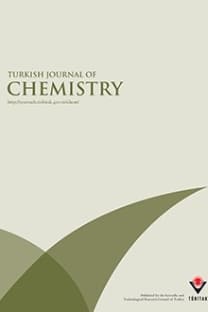Characterization of extracts from Papaver rhoeas and potential valorization of these extracts in dyeing applications
Characterization of extracts from Papaver rhoeas and potential valorization of these extracts in dyeing applications
___
- 1. Mirjalili M, Nazarpoor K, Karimi L. Extraction and identification of dye from walnut green husks for silk dyeing, Asian Journal of Chemistry 2011; 23 (3): 1055– 1059.
- 2. Samanta A.K, Agarwal P. Application of natural dyes on textiles. Indian Journal of Fibre and Textile Research 2009; 384-399.
- 3. Merdan N, Acar K, Korkmaz B. Investigation on colour and fastness properties of wool fabrics dyed with Papaver rhoeas L. University of Istanbul, Turkey, 2011; 1019 s.89-99.
- 4. Ali S, Hussai T, Nawaz R. Optimization of alkaline extraction of natural dye from Henna leaves and its dyeing on cotton by exhaust method, Journal of Cleaner Production 2009; 17: 61–66.
- 5. Manhita A, Ferreira T, Candeias A, Barrocas Dias C. Extracting natural dyes from wool—an evaluation of extraction methods. Chemistry Department and Évora Chemistry Centre, University of Évora 2011; doi: 10.1007/s00216-011 4858
- 6. Prabhu KH, Teli MD. Eco-dyeing using Tamarindusindica L. seed coat tannin as a natural mordant for textiles with antibacterial activity. Journal of Saudi Chemical Society 2014; 18: 864–872.
- 7. Cunningham AB, Maduarta IM, Howe J, Ingram W, Jansen S. Hanging by a Thread: Natural Metallic Mordant Processes in Traditional Indonesian Textiles. Economic Botany 2011; 65 (3): 241-259.
- 8. Gedikgorkem, Arzuyavas, Ozanavinc, Ömersimsek. Cationized Natural Dyeing of Cotton Fabrics with Corn Poppy (Papaver rhoeas) and Investigation of Antibacterial Activity. Asian Journal of Chemistry 2013; 25 (15): 8475-8483.
- 9. Merdan N, SahinbaSkan B Y, Kocak D, ARI G. Colour and Fastness Properties of Silk Fabrics Dyed With Colours Obtained From The Flowers of The Papaver Rhoeas L. (Common Poppy). Asian Journal of Chemistry 2012; 24 (10): 4295-4299.
- 10. Maurizi A, De Michele A, Ranfa A, Ricci A, Roscini V, Coli R, Bodesmo M, Burini G. Bioactive compounds and antioxidant characterization of three edible wild plants traditionally consumed in the Umbria Region (Central Italy): Bunias erucago L. (corn rocket), Lactucaperennis L. (mountain lettuce) and Papaver rhoeas L. (poppy). Journal of Applied Botany and Food Quality 2015; 88:109–114.
- 11. Sebnem SI, Sagiroglu A. Une évaluation des In vitro Activités anti oxydantes de différents extraits de Papaver rhoeas L. Feuilles International Journal des propriétés alimentaires 2012 ; 15 (6) : 1300-1308, doi: 10.1080 / 10942912.2010.520542
- 12. Bayram DD, Yigit E, Akbulut GB. The effects of salicylic acid on Helianthus annuus L. exposed to quizalofop-p-ethyl. American Journal of Plant Sciences 2015; 6: 2412-25.
- 13. ISO 105-C03, Textiles - Tests for Colour Fastness - Part C03: Colour Fastness to Washing: Test 3, 1989
- 14. Singleton VL, Rossi JA. Colorimetry of total phenolics with phosphomolybdicphosphotungstic acid reagents. American Journal of Enology and Viticulture 1965; 16: 144-158.
- ISSN: 1300-0527
- Yayın Aralığı: 6
- Yayıncı: TÜBİTAK
Antiinfective properties of ursolic acid-loaded chitosan nanoparticles against Staphylococcus aureus
Fatemeh GHASEMZADEH, Ghasem D. NAJAFPOUR, Maedeh MOHAMMADI
Zekeriya BIYIKLIOĞLU, Burak BARUT, Hüseyin BAŞ
Fuxiang LI, Ganqing ZHAO, Yibo WU, Yongjun HAN, Songtian LI, Guoxv HE, Qingbin LI, Xuerong SUN, Peisong LIU, Shiying LUO, Liping CHENG
New iodine-apatites: synthesis and crystal structure
Evgeny N. BULANOV, Sergey S. PETROV, Alexander V. KNYAZEV
Ali Şems AHSEN, Osman ÖZTÜRK, Oğuz Kaan ÖZDEMİR, Aydın HAŞİMOĞLU, İnci KARAASLAN
Majd Ahmed JUMAAH, Nadia SALIH, Jumat SALIMON
Laccase bound to cryogel functionalized with phenylalanine for the decolorization of textile dyes
Bo MATTIASSON, Adil DENİZLİ, Yusuf Doruk ARACAGÖK, Neslihan İDİL, Işık PERÇİN
